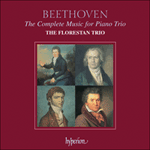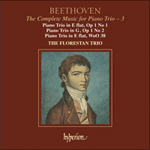
Welcome to Hyperion Records, a British classical label devoted to presenting high-quality recordings of music of all styles and from all periods from the twelfth century to the twenty-first.
Hyperion offers both CDs, and downloads in a number of formats. The site is also available in several languages.
Please use the dropdown buttons to set your preferred options, or use the checkbox to accept the defaults.

| The Florestan Trio» More |
Haydn and Mozart wrote many Andantes in gently swaying 6/8 siciliano rhythm. But only rarely did they compose a siciliano in the slower, Adagio tempo. It is characteristic of the young Beethoven’s search for increased profundity of expression that the second movement of the G major Trio combines a siciliano lilt with an unprecedented hymn-like solemnity. The tempo marking, Largo con espressione, is itself novel and significant; and the rapt atmosphere is enhanced by the choice of key, E major, which sounds remote and radiant after G major. Beethoven shows a typical feeling for long-range tonal planning when he later plunges dramatically (with a sudden fortissimo) from B major to the work’s home key of G, initiating a searching modulating development of the opening theme.
Though definitely a scherzo rather than a minuet, the third movement is less wilful than its counterpart in Op 1 No 1, playing insouciantly with rising and falling scales, à la Haydn. The Trio turns to B minor for a laconic waltz of comic banality – the kind of music likely to turn up in Beethoven’s works from the early years right through to the visionary late quartets. After the return of the scherzo Beethoven appends a brief coda that toys with the theme’s opening figure before dying away to pianissimo.
The finale was originally in 4/4 time. But at an early run-through the cellist Anton Kraft (best-known for his association with Haydn) suggested that the music would be better notated in 2/4, and Beethoven duly adopted the idea. Opening with a catchy ‘riding’ theme in rapid repeated notes (perfect for the violin, but artfully refashioned when the piano takes it over), this is another movement that infuses Haydn’s spirit with Beethoven’s own brand of boisterousness. The music is full of aggressive sforzando accents, rough dynamic contrasts (at their most extreme in the coda) and mysterious or dramatic plunges to distant keys. The development alights for a while in E major, the key of the Adagio – another instance of Beethoven’s large-scale tonal strategy. But perhaps the wittiest moment of all comes with the start of the recapitulation. Here a smooth new figure in octaves on the piano seems to be preparing for the return of the ‘riding’ theme, which then enters unobtrusively, before we realize it, while the piano octaves continue as if nothing has happened.
from notes by Richard Wigmore © 2004
Auteurs de maints Andante dans un rythme de sicilienne doucement oscillant à 6/8, Haydn et Mozart ne composèrent que rarement une sicilienne dans le tempo de l’Adagio, plus lent. Révélant une quête de profondeur d’expression accrue chez le jeune Beethoven, le second mouvement du Trio en sol majeur marie un rythme du sicilienne à une solennité hymnique sans précédent. L’indication de tempo, Largo con espressione, est en soi novatrice et significative, cependant que l’atmosphère captivante est rehaussée par le choix de la tonalité, mi majeur, qui semble lointaine et rayonnante après sol majeur. Beethoven fait montre d’un sens bien à lui de l’agencement tonal à long terme lorsque, plus tard, il plonge spectaculairement (avec un fortissimo soudain) de si majeur à la tonalité mère de l’œuvre (sol), déclenchant un rigoureux développement modulant du thème d’ouverture.
Pour tenir assurément plus du scherzo que du menuet, le troisième mouvement n’en est pas moins moins obstiné que son pendant de l’op.1 no1 et joue, de manière insouciante, avec des gammes ascendantes et descendantes, à la Haydn. Le Trio passe à si mineur pour une valse laconique, d’une banalité dérisoire – un genre de musique susceptible d’apparaître dans les œuvres du Beethoven des premières années comme des derniers quatuors visionnaires. Passé le retour du scherzo, le compositeur appose une brève coda qui joue avec la figure d’ouverture du thème avant de s’éteindre sur un pianissimo.
Le finale était originellement à 4/4 mais, lors d’une des premières répétitions, le violoncelliste Anton Kraft (mieux connu pour ses liens avec Haydn) suggéra que la musique gagnerait à être notée à 2/4 – ce que Beethoven fit. S’ouvrant sur un thème «chevauchant», facile à retenir, en rapides notes répétées (parfaites pour le violon et astucieusement remodelées lorsque le piano les reprend), il s’agit, là encore, d’un mouvement qui insuffle à l’esprit haydnien le sceau tumultueux beethovénien. La musique est toute accents agressifs sforzando, âpres contrastes dynamiques (à leur extrême dans la coda) et mystérieuses, ou spectaculaires, plongées dans des tonalités lointaines. Le développement fait un instant halte en mi majeur, la tonalité de l’Adagio – nouvel exemple de la stratégie tonale à grande échelle de Beethoven. Mais le moment le plus spirituel survient peut-être avec le début de la reprise: une régulière figure nouvelle, en octaves, au piano, semble préparer le retour du thème «chevauchant», qui fait une entrée discrète, avant même que nous nous en apercevions, tandis que les octaves du piano se poursuivent comme si de rien n’était.
extrait des notes rédigées par Richard Wigmore © 2004
Français: Hypérion
Haydn und Mozart komponierten zahlreiche Andantes im sanft wiegenden Siciliano-Rhythmus im 6/8-Takt. Doch nur selten schrieben sie ein Siciliano im langsameren Adagio-Tempo. Es ist für die Suche des jungen Beethoven nach mehr expressivem Tiefgang charakteristisch, dass der zweite Satz des G-Dur-Trios den Schwung eines Siciliano mit unerhörter hymnischer Feierlichkeit zu verbinden weiß. Die Tempoangabe Largo con espressione ist an sich schon neuartig und bedeutungsvoll; und die verzückte Atmosphäre wird noch verstärkt durch die Wahl der Tonart E-Dur, die im Anschluss an G-Dur entlegen und stahlend klingt. Beethoven beweist seinen typischen Sinn für vorausschauende Tonartplanung, wenn er die Musik später dramatisch (mit unvermitteltem fortissimo) von H-Dur in die Grundtonart G-Dur abstürzen lässt und damit eine eingehende, modulierende Durchführung des Anfangsthemas einleitet.
Obwohl es sich beim dritten Satz eindeutig um ein Scherzo handelt, nicht um ein Menuett, ist er weniger mutwillig als sein Gegenstück aus op. 1 Nr. 1 – der Satz spielt unbekümmert à la Haydn mit an- und absteigenden Tonleitern. Nun wendet sich das Trio für einen lakonischen Walzer voll komischer Banalität der Tonart h-Moll zu – diese Art Musik durchzieht Beethovens Schaffen von den frühesten Jahren bis hin zu den visionären späten Quartetten. An die Rückkehr des Scherzos hängt Beethoven eine kurze Coda, die ihr Spiel mit der Eröffnungsfigur des Themas treibt, ehe sie pianissimo erstirbt.
Das Finale stand ursprünglich im 4/4-Takt. Doch bei einer frühen Durchspielprobe meinte der Cellist Anton Kraft (heute vorwiegend für seine Verbindung zu Haydn bekannt), die Musik wäre angemesser in 2/4 notiert, und Beethoven übernahm den Vorschlag auch prompt. Dieser Satz, der mit einem eingängigen „Reiterthema“ in raschen wiederholten Noten einsetzt (sie liegen perfekt für die Violine, werden jedoch kunstvoll umgearbeitet, wenn das Klavier das Thema übernimmt), pflanzt dem Geist Haydns wiederum Beethovens eigene Sorte Ausgelassenheit ein. Die Musik ist voller aggressiver sforzando-Akzente, heftiger dynamischer Kontraste (am extremsten in der Coda) sowie mysteriösen oder dramatischen Sprüngen in entlegene Tonarten. Die Durchführung setzt sich eine Weile in E-Dur fest, der Tonart des Adagio – ein weiteres Beispiel für Beethovens groß angelegte Tonartstrategie. Doch der geistreichste Einfall von allen macht sich am Beginn der Reprise bemerkbar. Hier scheint eine glatte neue Figur in Oktaven auf dem Klavier die Rückkehr des „Reiterthemas“ vorzubereiten, das dann unauffällig einsetzt, ehe wir es so recht bemerken, während sich die Klavieroktaven fortsetzen, als sei nichts geschehen.
aus dem Begleittext von Richard Wigmore © 2004
Deutsch: Anne Steeb/Bernd Müller
 Beethoven: The Complete Music for Piano Trio Beethoven: The Complete Music for Piano TrioEach instalment of The Florestan Trio’s Beethoven Piano Trio cycle was rapturously received. Now reissued as a special-price box-set, this superb series of benchmark recordings should not be missed.» More |
 Beethoven: The Complete Music for Piano Trio, Vol. 3 Beethoven: The Complete Music for Piano Trio, Vol. 3‘The Florestan Trio seems determined to extract every last ounce of energy, wit and spirit from these early works … the principal vehicle for con ... ‘Susan Tomes's dancing, crystalline passagework is a constant delight; instrumental repartee is delectably crisp and pointed; and the players are acut ...» More |

